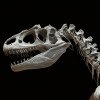DNA Origami
Interview with
It’s not just technology that folds in special ways, biology does too, including DNA. But how does DNA fold, and what can you do with that? Ulrich Keyser is from the Cavendish lab in Cambridge and he joined Chris Smith…
Ulrich- The reason why we want to do this, because structure and function are closely related and especially on small length scales, you really need to control the position of every atom in a molecule to make a certain function and DNA we understand so well because since Watson and Crick found out that you have a double helix, you can actually manipulate this material now in that way that you can really build on molecular length scale whatever you want.
Chris - So it's not for its ability to carry information in a genetic way that you're using DNA, you're using it because we understand very well how it effectively organizes itself in three dimensional space because of its chemistry.
乌尔里希-没错。因为我们准确理解w the information carrying works, we can program a certain information and this will then fold into a three dimensional shape that we give. So it's like taking Lego bricks where you just take whatever, green, red and blue one and then put them a little bag, shake them, and then you open the bag, the green and the red and the blue one are all connected in the right way and then you can make this into complex three dimensional shapes.
Chris - So when you want to do this, do you literally have a computer program that says, "that's the shape I want to make"? And then you synthesize a string of DNA letters all linked together that just makes you the lump of DNA and then as you do that, it's assembling itself because of the chemistry of DNA into the structure you thought?
Ulrich - It's so easy, as you just said. So we have a shape in mind, for instance, a barrel or a ring and then we put into a computer program and the computer program calculates the lowest energy state for these kinds of systems. And then it spits out normally 200 small sequences or DNA pieces that we have to order from a company. And it's now all automated almost, we just sent an email to the company and a week later you get it in the post. You mix everything together, heat it up, cool it down and then you have billions of these structures in your teacup. Now with advancements in chemistry, you can even put different chemical groups in different places. So for instance, nature uses these kind of molecules for capturing light and we can do the same or we can actually build small mimics of proteins that actually do the functions in cells. We can now build them from DNA molecules that we forced into these kinds of shapes.
Chris - Well, I'm glad you brought that up because I was going to ask a lot of people listening to this probably thinking, it sounds like you're having a lot of fun doing this, but what's the point? But this means that you've potentially got the ability to exactly control where things are in three dimensional space, at the atomic level, so you can build tiny, tiny, tiny things with enormous precision.
乌尔里希-没错。So what we can actually do, we can make these DNA molecules to drill a hole into a cell. What we are interested in at the moment is to see how we can actually build these kind of ion channels that control flow through a cell membrane from DNA.
Chris - Because the body does that by using proteins, doesn't it? That's another polymer made by linking together molecules called amino acids. And the body builds those up and they form and assemble into these big complicated three dimensional structures. So you're saying, I'm going to use DNA to make a replica of that, which it might be made of a slightly different material, but it's going to look the same and it sure as hell is gonna work the same. It's kind of like the nanoscale equivalent of a hip replacement where instead of you putting an artificial hip in, which works like a hip joint, but it's obviously not made of the same stuff, you're doing a similar sort of thing.
乌尔里希-没错。And the big advantage there is that DNA is of course inherently biocompatible. So we hope that with this kind of approach, we can really make biocompatible medicine that can be tailored to certain patients because you have the flexibility in building whatever you want for a certain disease or certain person.
Chris - Oh, neat. Because we know a lot of diseases, for instance heart abnormal rhythms and so on, are because some of the channels in the heart that convey electricity through the muscle cells are the wrong shape. So you could potentially then knock up a new structure out of DNA and put that into the heart cells to stabilize a heart rhythm?
Ulrich - Fundamentally what you can do is you can take these ion channels made from DNA, add them to muscle cells, also to neurons actually, and then see how they change their behaviour.
Chris - Are we very far away from actually realizing tractable, tangible examples of this in industry and in the real world?
Ulrich - Prediction of this kind of thing is very difficult. But I think that personalised medicine will come a long way in the coming years and I'm pretty sure that some of this technology will end up pretty soon in patients. I mean, pretty soon means 10 years.









Comments
Add a comment